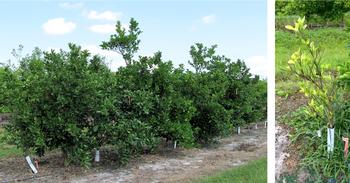Disease resistance in citrus with addition of plant defense genes

Research by Drs. Manjul Dutt and Jude Grosser, University of Florida
Article written by Manjul Dutt, Jude Grosser, Elizabeth Grafton-Cardwell, Peggy G. Lemaux, & Lukasz Stelinski.
Revised May 1, 2017.
What is the technique?
Many plants defend themselves from pathogens (and insect feeding) by producing proteins that enhance their resistance to these organisms. This is called systemic acquired resistance (SAR). Specific defense genes code for pathogenesis related (PR) proteins that protect plants from microorganisms and are induced by a plant hormone called salicylic acid. Genes from resistant or tolerant plants can be inserted into less tolerant ones, thereby improving disease resistance traits in those varieties that are highly susceptible to disease. This use of genetic engineering is a relatively fast method of improving existing cultivated plants by enhancing their resistance to newly introduced pathogens.
How is genetic engineering involved?
The model plant, Arabidopsis, was used in this research. A gene called Non-expressor of Pathogen Related genes 1 (NPR1) has been identified in this plant. Arabidopsis mutants that lack expression of the NPR1 gene do not respond to pathogens by producing protective proteins, while engineered plants over-expressing NPR1 genes have enhanced resistance to several pathogens, ranging from fungal to bacterial. Researchers have recently taken this approach to protect citrus from huanglongbing disease (HLB). They developed transgenic trees that overexpress an NPR1 gene in the phloem tissues (where the HLB pathogen occurs) of both ‘Hamlin’ and “Valencia’ sweet oranges. These varieties are the most predominant sweet oranges grown in Florida and Brazil for juicing.
Transgenic citrus trees were developed by inserting a phloem-specific Arabidopsis gene promoter (gene region that drives production of the NPR1 protein). This insures that overexpression of these NPR1 defense genes happens in that tissue. The idea was to engineer normally susceptible plants to be resistant to HLB by boosting their natural ‘immune’ defense to this disease. The transformed plants were propagated and grafted onto a common rootstock. Plants transformed to express resistance to HLB were evaluated by exposing them in the laboratory to free-flying Asian citrus psyllids that were carrying the pathogen. Also, transgenic plants (and non-transformed controls) were planted in citrus groves with a high (>90%) incidence of disease. The researchers found that by overexpressing an NPR1 gene they created citrus trees that were more resistant to HLB than controls. A few of the tested transgenic lines remained free of disease for up to 36 months after exposure in the field investigation. In comparison, control plants became infected after only 6 months in the field.Who is working on the Project?
Drs. Manjul Dutt and Jude Grosser conceived, designed, and have led this research. They lead laboratories at the University of Florida’s Citrus Research and Education Center in Lake Alfred, Florida.
What are the challenges and opportunities?
This research points to one possible important tool for combating HLB directly with transgenic trees that show increased natural immunity to the disease. Transgenic plants are in many ways similar to plants released through traditional breeding methods. However, consumer education regarding their safety continues to be needed. Research is also underway to examine if transforming the rootstock of commercial citrus trees alone without manipulating the scion (fruiting portion of the tree) might have the same effects. The idea is to boost the immunity of the entire tree by genetically engineering only the root portion of the commercial tree. In this manner, the scion, which is grafted on later and grows above ground to produce fruit, would not express any of the engineered genes and therefore harvested fruit would not be considered engineered.
Source: Dutt M, Barthe G, Irey M, Grosser J (2015) Transgenic Citrus Expressing an Arabidopsis NPR1 Gene Exhibit Enhanced Resistance against Huanglongbing (HLB; Citrus Greening). PLoS ONE 10(9): e0137134. doi:10.1371/journal.pone.0137134
Funding source: This project is funded by the Citrus Research and Development Foundation.


